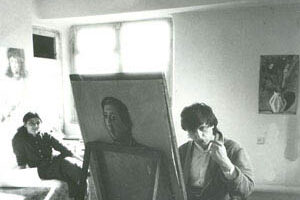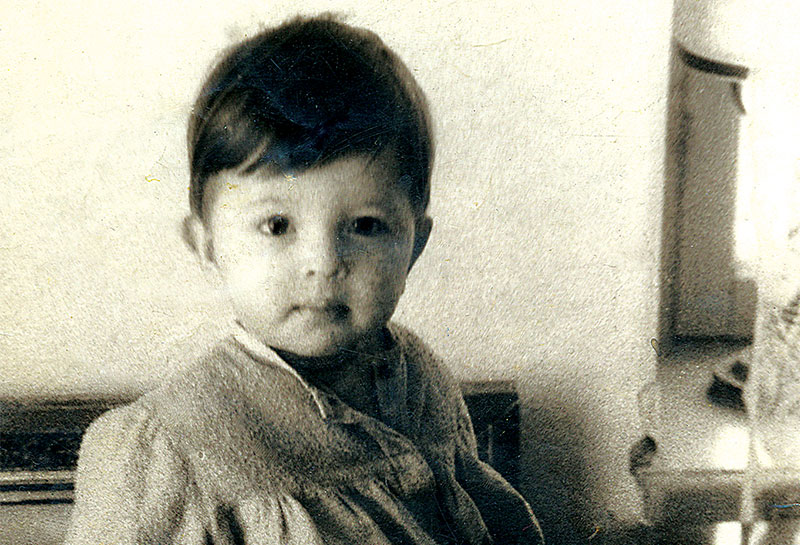GOSPELS BY IRAKLI PARJIANI

Irakli Parjiani belongs to a small group of outstanding artists of the 20th century. When mentioning his name, it is not his works that come to mind first but the bridge that he constructed between the past and the future of art and we imagine the artist himself as being a beacon in the centre of this junction.
Irakli Parjiani’s works appeared in Georgian painting in the 1970s and, strangely enough, he was immediately highly acclaimed as an artist with his own style realized in his own world of colors and images. His art is varied and multi-colored in artistic value as well as in the uniqueness of the themes and in the variety of the genres employed. Everything that by its form and significance fitted his vast intellectual outlook and offered great opportunities to his powerful imagination was incorporated within the sphere of his interests.
Presumably, this explains the fact that Irakli Parjiani’s style is unique and easily recognizable not only due to its artistic features but be-cause of its emotional and spiritual contents. It is equally exciting for the viewers of different generations, tastes and aspirations.
Irakli Parjiani’s art can hardly be divided according to chronological or any other possible principles. The painter is in permanent quest with regard to the genre and all his attempts are directed to broaden-ing its traditional borders: he seems to be plunged into looking for an appropriate style in the genre painting. The pictures painted by the artist in pastel and in oil colors reflect a calm and quiet co-existence of the elements of still-lifes and landscapes, and in a mixture with unreal components a dream like effect is created. His boats, rest-ing on a stony coast in the background of huge and strange flowers are part of the world where fairy tales turn to reality and this reality is undergoing a magic transformation almost in front of our eyes. The painter’s will often subdues incompatible and opposing features and by way of their synthesis achieves quite unexpected effects. He is try-ing to find strength in fragile things, stability in lightness and power in flexible and subtle objects; thus, his pictures are free of homogeneity. The still-lifes with various bouquets of strange flowers seem light and aerial, as if put together accidentally. Their composition can hardly be changed and the structure of the flowers outlined only in general contours is clear cut and strong.
Irakli Parjiani is never and nowhere interested in one or two features of an object or event or even in the essence of things but his inter-est always lies in both sides of the borderline separating concrete realities; these sides are interesting and significant per se, but life, which is unique and picturesque, can only be born in the midst of their junction point.
While designing books, being a co-author of the narrative, I. Parjiani shares deeply the style and aspiration of the work and on the other hand, as a reader and interpreter, he manages to maintain freedom by way of
manifesting a clear-cut individuality. The books designed by him are totally different from each other, although his peculiar characters and the indistinct manner of painting make the author’s identity unmistakably recognizable. Freedom of expression and the capacity of such transformation of styles derives its roots from the complete unique-ness of the personality of the painter.
Co-existence of the concrete and the general in Irakli Parjiani’s works becomes more striking when he is engaged in painting pictures on Christian themes. The annunciation, crucifixion and the Last Supper are the themes embodied by him and not only once. Irakli Parjiani’s creative talent is marked with a remarkable sense of spirituality. Therefore, it is not strange that all his art is saturated with a keen interest in religious themes. While viewing these pictures, it becomes clear as to what extent his artistic “language” and the pallet are grow-ing richer and more perfect and how skillfully he masters the infinite color spectrum. His ability to condense each color in order to enable it to emanate light is outstanding. His special attitude to light is reflected in all his works and ideas; he also emphasizes that his artistic tool
is not color but light itself. This is the factor that defines the remark-able splendor of the colors of his pallet. Sometimes scratched and sometimes almost carved lines of the surface of his works seem to be spontaneously elaborated. Such an effect of free expression, though utterly modern, yet forms a junction of the richest artistic traditions; this is an additional feature making Irakli Parjiani a leader in contem-porary Georgian painting. His art responds to the cardinal problem of the 20th century – the interrelationship of the new and the old or in other words, of tradition and innovation and by its harmony, closeness to nature and to emotional explores the yet unexhausted opportunities of real painting.
It seems that for Irakly Parjiani the world was not segmented or divided by any type of borders; life itself meant unity and wholeness to him and reflection of such completeness was his paramount mis-sion. By his work he was somewhat “ahead” of his time, yet he was creating art full of lively artistic impulses which in the course of time and in the context of modern art are acquiring more and more exciting features. Irakli Parjiani’s world represents an imprint of harmonious co-existence of the personal and artistic characteristic features of the artist; the master who is well aware of the price of sincerity and who is in permanent quest of spiritual values does not need any superla-tive degree of praise; for posterity the simple title: “Irakli Parjiani, the painter” would be sufficient reward.
Nino Gaganidze Art Historian, PH.D.
In 1978, when religion remained the subject of ideological prohibition and persecution, 28-year-old Irakli Parjiani started transcribing and illustrating the Gospels. He dedicated one year to the studies in calligraphy and ancient manuscripts at the Institute of Manuscripts, and later continued working on his selected theme for two years. He fully copied the Gospels of John and Mark and illustrated them, producing the book of Mark in bound form and the book of John unbound. Later, he created relatively few illustrations for the Gospel of Luke. In much the same way as the handwritten books from the Middle Ages, Parjiani’s version of the Gospel is a complete, finished manuscript decorated with miniatures, and elements of the headings and endings that combine into a single traditional and innovative work. The text is structured like a rosary – demonstrating the artist’s diligence, as if he uses the text for praying while writing. The text of the Gospel of John is enriched with miniatures and individual images that resemble ruby, amber, emerald, turquoise, and purple gemstones scattered among the orderly structured lines. The book creates the illusion of a flourishing plant, where the text is formed through the stems, branches, and entangled roots. The miniatures dispersed on the paper represent open flowers and fruits that pulsate with internal energy. In this work the sensation of the illusion of a living object is very strong. This is the point of departure for Parjiani’s entire oeuvre, reviving visual objects, turning them into “icons,” keeping them on the verge of transformation, giving them a soul, melting them in space and transforming them into the light. According to the artist “all matters represent condensed light.” His position of creating any object, character, space through the materialization of light supports the argument for the existence of the universe thanks to divine will. As such, all fields of his work: “metaphysical landscapes,” the compositions of “the encounters,” flowers, still-lives, portraits, the Berlin Cycle, and sketches are all produced based on this principle and offer a unified system of symbols, where the impulse of reviving, shape-shifting and breathing matter, capturing the soul of the object are elevated through the vibration of color, light and line to such an extent that each of the elements seems to explode in front of our eyes with the energy of transformation, at the same time abandoning their own meaning and turning into a different substance. We are convinced of the existence of an invisible world, and the mission of the artist to introduce it to us – an act that Parjiani performs in a virtuous manner.
Parjiani’s Gospels simultaneously exude the scent of the Middle Ages, and in parallel bear the features of modern culture, uniting in one the canonical iconography of hand-written religious books with the independent interpretations of the artist. It is incredible that Soviet Georgia allowed the creation of a unique version of the Gospel that has no analogue. Parjiani acts like a copyist of the Medieval Gospels
– a feature he may have inherited from his ancestors of the school of copyists in Svaneti. This is the only occurrence of copying and illustrating the Gospel in Georgian painting since the Middle Ages. This act becomes even more remarkable when we recall that in the Soviet Union, working on the Gospel was dangerous for an artist, and the presentation of such a book remained completely unimaginable in the existing environment at that time.
Parjiani’s work starts with illustrations of the Gospels and ends with the Berlin Cycle, in between he created a diversity of miniatures and monumental paintings. The artist unites the ideas, motives, and concepts of these two cycles, perfecting them through the application of his methods, knowledge, and mastery.
In Georgian art, his name is associated with the rehabilitation and transformation of religious paintings. All trends, motifs, themes, characters, or systems of symbols eventually merge into religious drawings, creating an independent individual model of his creativity. Irakli Parjiani is an amazing figure of Georgian art, who combined traditional and contemporary cultural systems, accumulated hidden knowledge about the universe, interpreted symbols and dreams, and the eternal themes of life and death, who “traveled” through metaphysical landscapes and painted the light. In the terrible realities of Georgia at the end of the 20th century, he managed to create a universe full of hidden tragedy, mysticism, the inevitability of vanity, and, at the same time, a celebratory presentation of life, which unites the aspects of light and beauty that are associated with eternal values. And, most importantly, thanks to his works he manages to convince us of their supremacy.
Baia Tsikoridze, Art Historian, PH.D.
EARLY LIFE
Irakli Parjiani was born on 22 May, 1950, in the town of Mestia, Upper Svaneti, in Georgia’s highest mountainous region.
The ancient Svanetian towers, the frescos and mural paintings well preserved up to this very day, old manuscripts, snow capped mountains, the Svanetian songs and dances make a unique impression on the visitors. Upper Svaneti is located 700-2200 meters high above sea level. Adjacent is the village of Ushguli which is considered to be the highest inhabited place in all Europe. Compared to other regions of Georgia this corner was more protected and therefore, it became a treasury of the unique cultural monuments of Georgia. Irakli Parjiani spent his childhood and young years there, in Mestia, in an environment of snow white peaks and mountains covered with coniferous forests.
Little Irakli grew up in the environment of artists and started painting at an early age. He attended preparatory courses in Tbilisi and after leaving school he took the entrance exams at the Department of Painting of the Academy of Art.
Irakli Parjiani studied in the Academy of Arts from 1968 to 1974; for the young artist those were the years of continuous quest, self-knowledge and self-assertion.
ADULTHOOD
In 1974, he graduated from Tbilisi Academy of Art.
In 1977, the painter presented to the Academy his diploma work – “The Pastor’s Family”, which was rejected because of its religious content. Later, Irakli presented another picture – “The Family” before the commission and finally, he was granted a diploma. After this, he engaged himself in free creative activity.
In 1978 he starts working on copying the Gospel of St John. Irakli Parjiani was well acquainted with world miniature painting: Georgian, Byzantine and Persian art. Hence, miniature turned out to be his most beloved genre. This is how Irakli comments upon his miniature illustrations of the Gospel: “Those are sketches for future large scale paintings”. Irakli Parjiani was diligently preparing himself to undertake this large-scale project during a whole year. He studied old Georgian manuscripts at the Institute of Manuscripts of Georgia and worked systematically on perfecting his calligraphy.
. It should be emphasized that in the entire Georgian and post-Soviet school of painting, Parjiani was the first to discover and use oil pastels. In the 80s he starts producing the desired pastel colors for his pictures and thus, paved the way to the specific, Parjiani style in painting.
MATURITY
By invitation of his friends, he travels beyond the borders of the Soviet Union to East Germany. Together with his familly wife Asmat Parjiani and daughter sofia he travels to the most picturesque towns of East Germany: Jena, Weimar, Erfurt, Naumburg, East Berlin and others. He spends almost a day in the Goethe Museum and the Cranach Museum and he enjoys the chance of visiting the Dresden Gallery to view the masterpieces of the representatives of the Netherlands’ school of painting.
It was in Berlin, where he settled with familly for years, where outstanding collection of epic paintings known as the “Berlin Cycle” was created.
In a few years, while staying in West Berlin Irakli sees the exhibits of the Check-Point-Charlie Museum and overwhelmed by the tragic fate of thousands of people he creates a painting which he called Check-Point-Charlie; this picture is a symbolic presentation of unity of a country and nation torn into two parts and very soon after, he happens to witness the reunification process of Germany.
on December 23, at the age of 41, died the master, one of the outstanding representatives of modern Georgian painting, Irakli Parjiani.
AWARDS
1992 Irakli Parjiani was awarded the State Price of the Republic of Georgia.
1996 was awarded of the Highest Price for Georgian artist Pirosmani Price.
PHOTO ARCHIVE
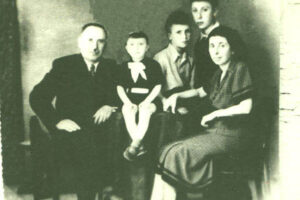
FAMILY
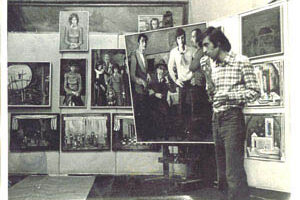
GRADUATION

WITH WIFE ASMAT PARJIANI
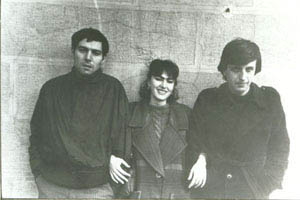
WITH FRIENDS, LEVAN CHOGOSHVILI AND TAMAR KHUNDADZE
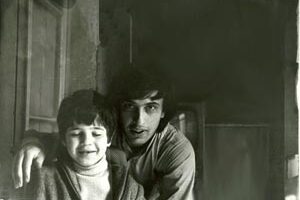
WITH SON BEQA
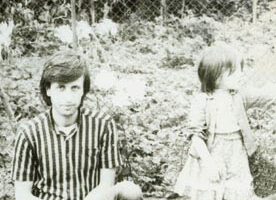
WITH DAUGHTER SOFIA
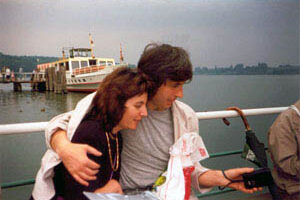
BERLIN, WITH WIFE
